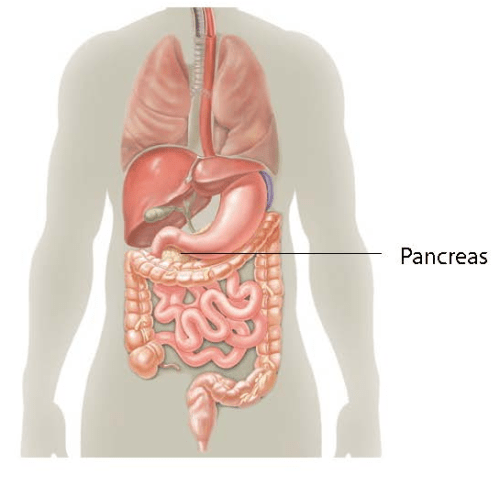PANCREAS

Pancreatic NETs include:
Associated Symptoms
Symptoms are typically those seen in Cushing syndrome that result from high levels of cortisol: weight gain, a full, rounded face, muscle weakness, high blood pressure, mood changes, excessive hair growth, abdominal obesity, purple-coloured lines on the skin, an unusual build-up of fatty tissue between the shoulder blades or just above the collarbone, high levels of glucose or low levels of potassium in the blood.
Symptoms are typically those seen in Cushing syndrome that result from high levels of cortisol: weight gain, a full, rounded face, muscle weakness, high blood pressure, mood changes, excessive hair growth, abdominal obesity, purple-coloured lines on the skin, an unusual build-up of fatty tissue between the shoulder blades or just above the collarbone, high levels of glucose or low levels of potassium in the blood.
Associated Symptoms
Symptoms may include non-watery diarrhea, severe weight loss, gallbladder disease and the presence of peptic ulcers without the high gastrin levels usually associated with peptic ulcer disease.
Symptoms may include non-watery diarrhea, severe weight loss, gallbladder disease and the presence of peptic ulcers without the high gastrin levels usually associated with peptic ulcer disease.
Associated Symptoms
Symptoms are related to high blood sugar: diabetes mellitus, mouth sores, blood clots in the leg or lung, diarrhea, depression, extreme fatigue or a skin condition called necrolytic migratory erythema that may appear as a red, swollen, painful or itchy rash – most commonly on the buttocks, legs and groin.
Symptoms are related to high blood sugar: diabetes mellitus, mouth sores, blood clots in the leg or lung, diarrhea, depression, extreme fatigue or a skin condition called necrolytic migratory erythema that may appear as a red, swollen, painful or itchy rash – most commonly on the buttocks, legs and groin.
Associated Symptoms
Symptoms are related to low blood sugar: confusion, irritability, sweating, dizziness, weakness, rapid heartbeat, periods of unconsciousness. Some symptoms may improve upon eating. Other symptoms may be related to an excess of catecholamines –substances such as epinephrine, norepinephrine and dopamine which elicit a “fight or flight” response, such as rapid heartbeat and increased blood pressure.
Symptoms are related to low blood sugar: confusion, irritability, sweating, dizziness, weakness, rapid heartbeat, periods of unconsciousness. Some symptoms may improve upon eating. Other symptoms may be related to an excess of catecholamines –substances such as epinephrine, norepinephrine and dopamine which elicit a “fight or flight” response, such as rapid heartbeat and increased blood pressure.
Associated Symptoms
Symptoms may not be evident in the early stages of disease but when they occur, will often include abdominal pain and occasional watery diarrhea. Examination may reveal an enlarged liver or metastases (spread of cancer) in the liver.
Symptoms may not be evident in the early stages of disease but when they occur, will often include abdominal pain and occasional watery diarrhea. Examination may reveal an enlarged liver or metastases (spread of cancer) in the liver.
Associated Symptoms
Symptoms generally present as bone abnormalities, similar to those seen in patients with high levels of parathyroid hormone. Other symptoms may include kidney stones, peptic ulcer, and neurological or psychiatric disturbances.
Symptoms generally present as bone abnormalities, similar to those seen in patients with high levels of parathyroid hormone. Other symptoms may include kidney stones, peptic ulcer, and neurological or psychiatric disturbances.
Associated Symptoms
Symptoms are related to an increased level of the hormone somatostatin: diabetes mellitus, gallstones, weight loss, diarrhea and fatty stool, abdominal pain, nausea and vomiting, appetite loss and low levels of stomach acid.
Symptoms are related to an increased level of the hormone somatostatin: diabetes mellitus, gallstones, weight loss, diarrhea and fatty stool, abdominal pain, nausea and vomiting, appetite loss and low levels of stomach acid.
Associated Symptoms
Symptoms are related to an increased level of the hormone vasoactive intestinal peptide, which increases intestinal activity: severe watery diarrhea, very low levels of potassium in the blood, low levels of stomach acid, muscle weakness and cramping, lethargy, flushing, heart rhythm disturbances, abdominal pain and dehydration. Other symptoms may include high levels of glucose or calcium in the blood.
Symptoms are related to an increased level of the hormone vasoactive intestinal peptide, which increases intestinal activity: severe watery diarrhea, very low levels of potassium in the blood, low levels of stomach acid, muscle weakness and cramping, lethargy, flushing, heart rhythm disturbances, abdominal pain and dehydration. Other symptoms may include high levels of glucose or calcium in the blood.
